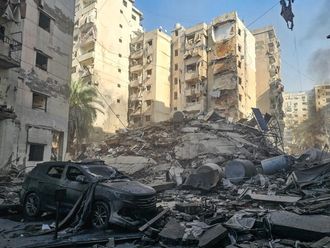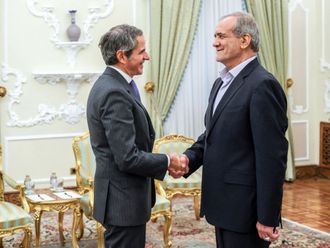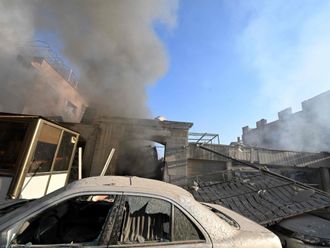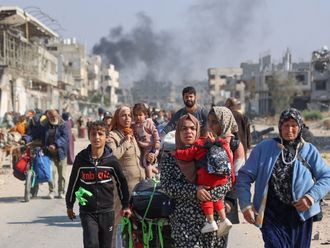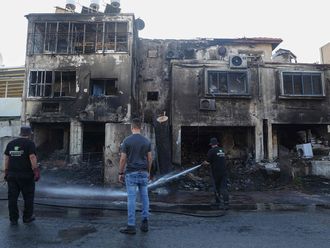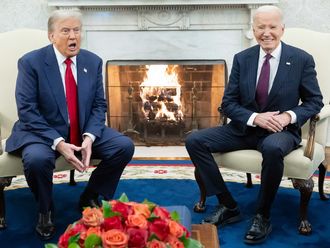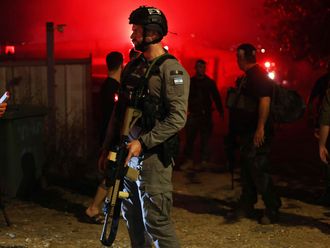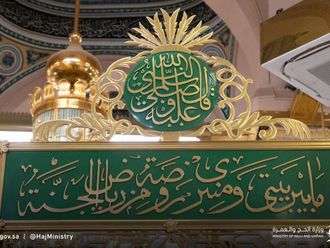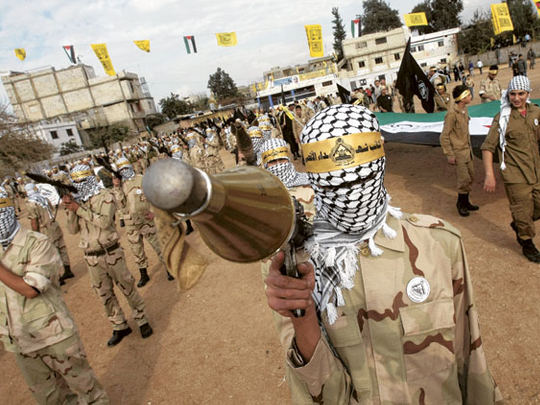
Ain Al Hilweh, Lebanon: The murder of a senior Al Qaida-inspired fighter and the exodus of other militants from here in recent months may herald some welcome stability for this impoverished Palestinian refugee camp.
With some 70,000 Palestinian refugees squashed into little more than a square mile near Sidon, Ain Al Hilweh lies outside the jurisdiction of the Lebanese government and has long been plagued by radicalism and factional violence.
But a tacit agreement for calm between a coalition of factions and the Fatah movement of Palestinian Authority President Mahmoud Abbas has left little space for militants seeking to plot and stage attacks against the Lebanese state or foreign targets in Lebanon.
"Fatah and the Islamist groups are working together. The security of the camp is a red line," says Mahmoud Eisa, popularly known as Lino, a top Fatah official in the camp. He heads up Fatah's Armed Struggle Faction in Lebanon, which is responsible for maintaining order in the country's Palestinian refugee camps.
Gandi "Abu Ramez" Sahmarani, the middle-aged leader of the now defunct Sunni jihadist faction Jund Al Sham, was found dead in a car park at dawn last Saturday. He reportedly was tortured and executed. There was no claim of responsibility for his death and, unusually, it has not triggered any serious reprisal violence. A small bomb explosion the next day against a shop owned by a figure in the Fatah movement was quickly played down.
There is no shortage of potential suspects behind Sahmarani's death. Among them is Fatah, which has regularly clashed with Jund Al Sham militants since the group first emerged in 2004; Lebanese military intelligence, which wanted Sahmarani for attacks he led against Lebanese army checkpoints in 2007; and possibly rivals within the small jihadist community in the camp.
Still, Sahmarani's death further reduces the influence of the dwindling band of jihadist militants remaining in Ain Al Hilweh. The camp's largest jihadist group, Esbat Al Ansar - listed by the United States as a terrorist organisation - has toned down its militancy since forging a tacit understanding with one-time rival Fatah to help keep stability in the camp.
That leaves a few isolated jihadists under threat of arrest or attack by Fatah and the Lebanese security authorities while living under the watchful eye of Esbat Al Ansar.
Notoriety
Sahmarani was living in a small quarter of the camp controlled by Esbat Al Ansar faction. The group gained notoriety in the 1990s for killing a prominent rival Islamic cleric in Beirut and fatally shooting four Lebanese judges in a court in Sidon.
Jund Al Sham was formed in 2004 and comprised several tiny jihadist factions and dissidents from the larger and more powerful Esbat Al Ansar. Jund Al Sham's founding leadership quit within months after a series of gunbattles with the secular Fatah, leaving Sahmarani in charge.
In the summer of 2008, several Jund Al Sham militants were targeted for assassination, reportedly by Fatah in cooperation with Lebanese military intelligence.
Wanted by Fatah and the Lebanese authorities, Sahmarani lived under virtual house arrest, rarely leaving his home and always informing Esbat Al Ansar of his movements.
Others travelled to Iraq to fight coalition forces, turned themselves in to the Lebanese army, or fled Ain Al Hilweh for European countries.
Escape
According to Eisa, the Fatah commander, around 20 to 25 militants escaped Ain Al Hilweh for Europe with the help of professional human smugglers. They reached Europe via Syria, Turkey and the Balkan countries.
"The pressure they are under made the situation very difficult for them here," Eisa says. Some of them appear to be seeking a better life by disappearing into immigrant communities in Europe, but there is always the risk that they may attempt to link up with cells of militants to carry out attacks. In April 2010, Emad Kroum, a former senior Jund Al Sham official, was arrested in Greece and extradited back to Lebanon.
Threats persist
Those who remain behind face high risks. In August, Lebanese intelligence agents shot and killed Abdul Rahman Awad, the leader of Fatah Al Islam, after he departed for Iraq.
Awad was wanted by the Lebanese authorities for staging attacks against Lebanese troops and United Nations peacekeepers in south Lebanon. He reportedly was replaced by Osama Shehabi, a former member of Jund Al Sham, who is believed to be still living in Ain Al Hilweh but is rarely seen.
"We still consider our camp under threat. We don't underestimate these guys. They are under surveillance all the time," Eisa says.
Still, given the tacit cooperation between former rivals Esbat Al Ansar and Fatah, the prospects of radicals gaining ground once more in Ain Al Hilweh remains dim, for now at least.
One veteran Palestinian commander says the key to stability is to abolish the influence of the Takfiri brand of Islam, which treats non-Muslims and even some Muslims as apostates and underpins the ideology espoused by Al Qaida. Mounir Moqdah, leader of Fatah's Al Aqsa Martyrs Brigade in Lebanon, says he has set up educational, athletic and moderate religious institutions for youngsters between the ages of six and 20.
"You can't fight Takfiri ideology with guns, but with institutions," he says. "They [the militants] won't find a base of support here. No one wants that ideology in the camp."
2007 camp battle was the catalyst
Ain Al Hilweh: The catalyst for the crackdown on the Ain Al Hilweh radicals came in 2007 when the Lebanese army was locked in a fierce 106-day battle with Fatah Al Islam, an Al Qaida inspired group in the Nahr Al Bared refugee camp in north Lebanon.
The fighting left more than 400 people dead and reduced the centre of the camp to rubble.
Days after fighting broke out in Nahr Al Bared, Sahmarani's Jund Al Sham militants attacked Lebanese army checkpoints on the edge of Ain Al Hilweh in support of their Islamist allies in the north. Twelve hours of clashes left two soldiers and two militants dead.
The fighting served as a wake-up call to Esbat Al Ansar and other allied Islamic militants in Ain Al Hilweh who realised that Jund Al Sham radicals could trigger a major attack by the Lebanese army similar to the confrontation then ravaging the Nahr Al Bared in the north.
Esbat Al Ansar agreed with traditional rival Fatah that it would keep watch over the more unruly Islamic elements in the quarter under its control, as both groups have a shared interest in preventing the situation in the camp from exploding.
"Esbat Al Ansar changed its leadership and they have played an important role [in keeping the peace]. They have the experience of many years and this has given them the right attitude and behaviour," said Shaikh Jamal Khattab, leader of the coalition of Islamic factions in Ain Al Hilweh, in a recent Monitor interview.


